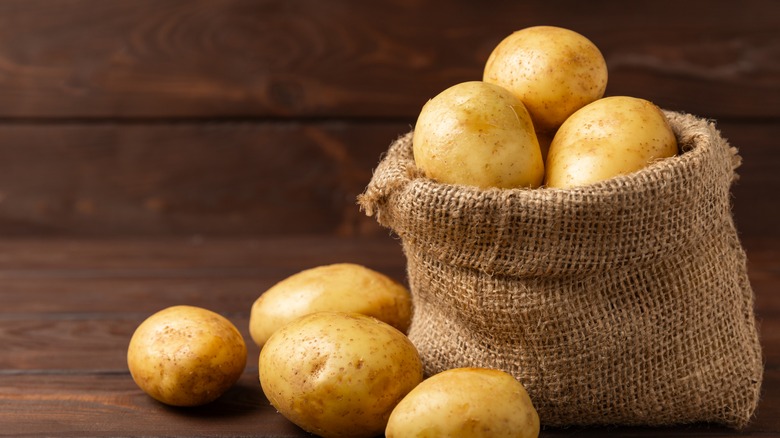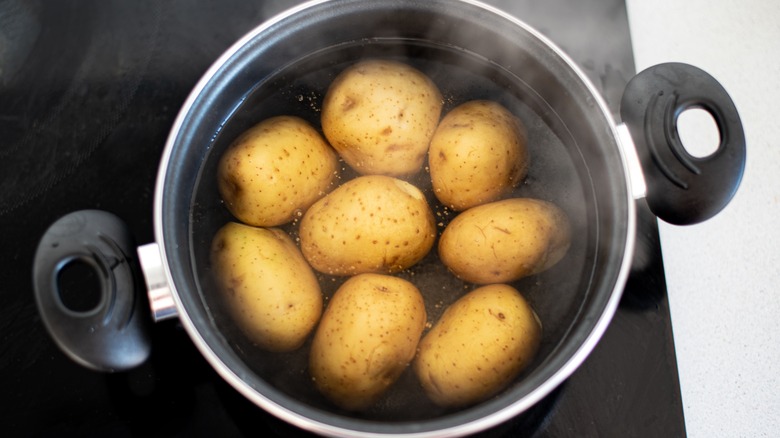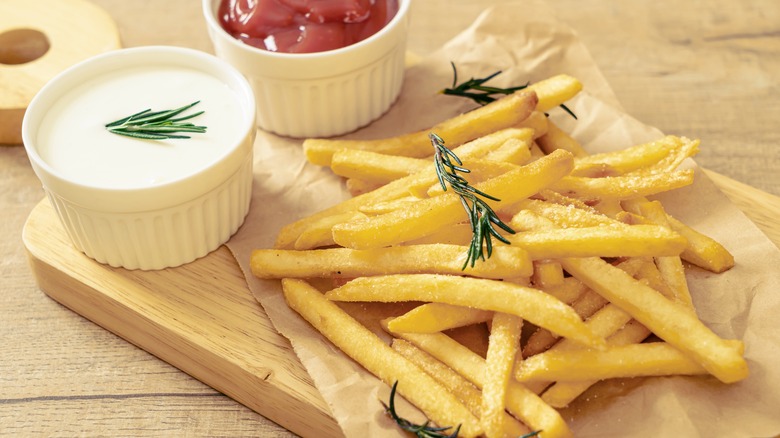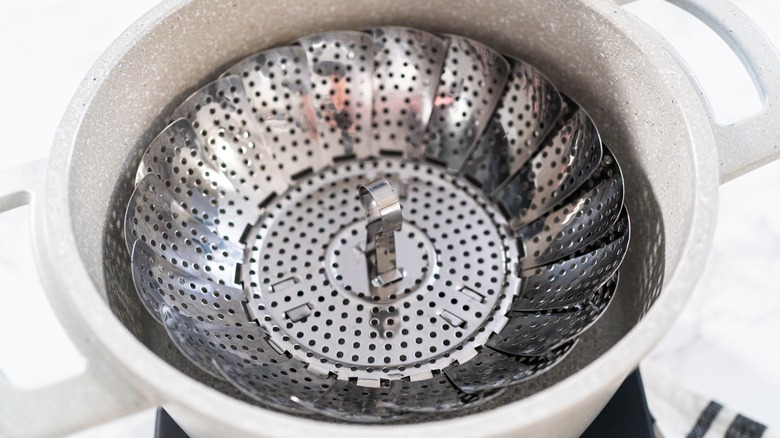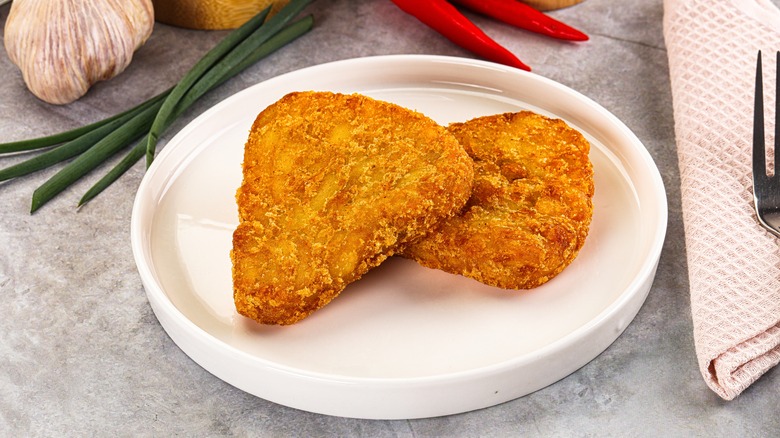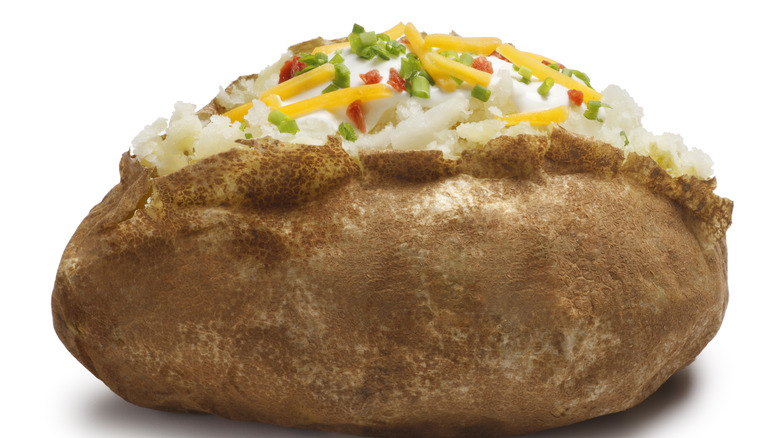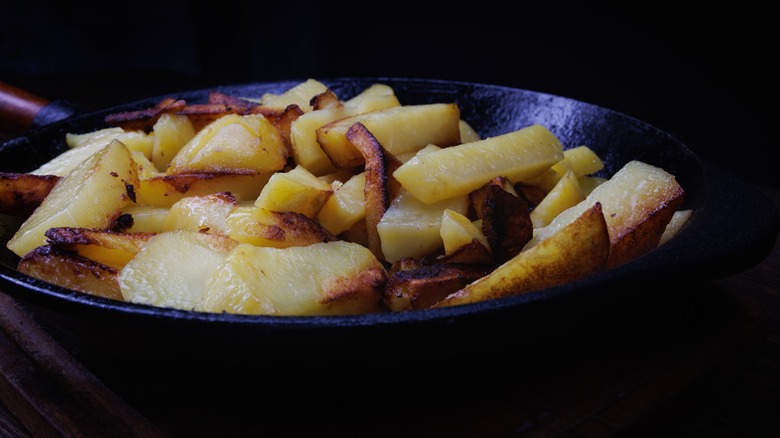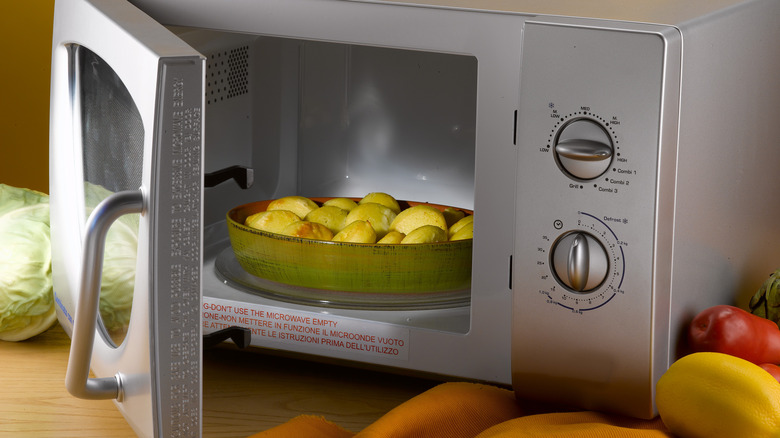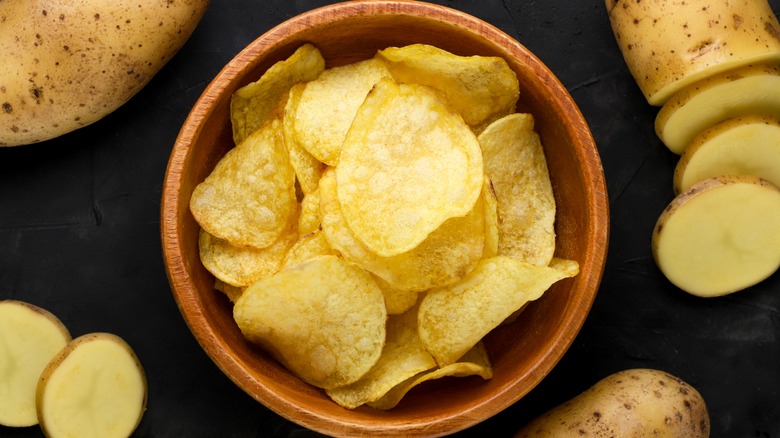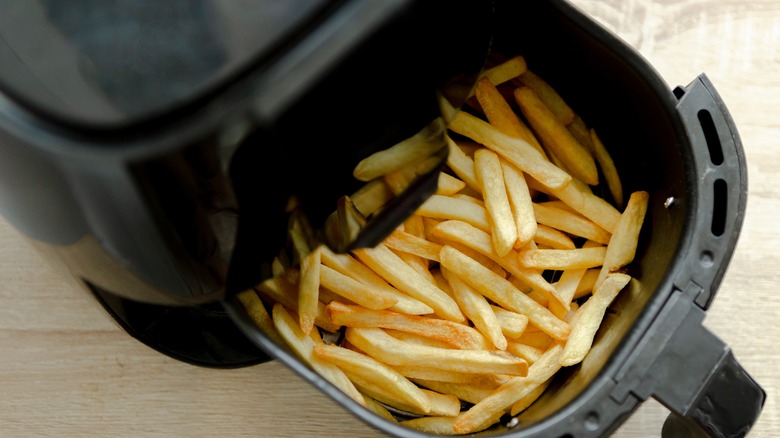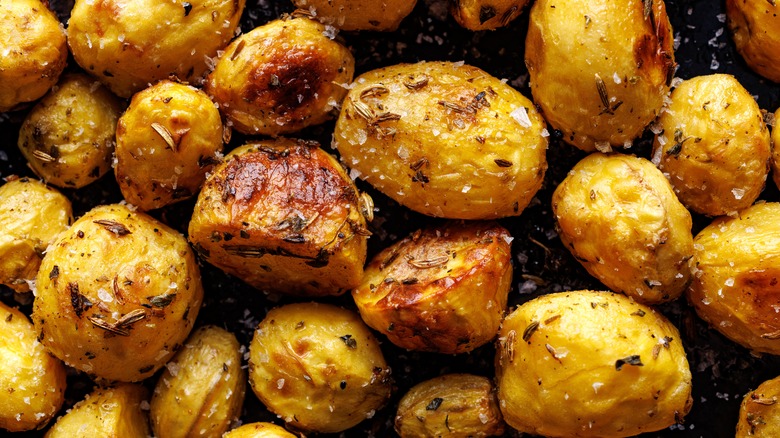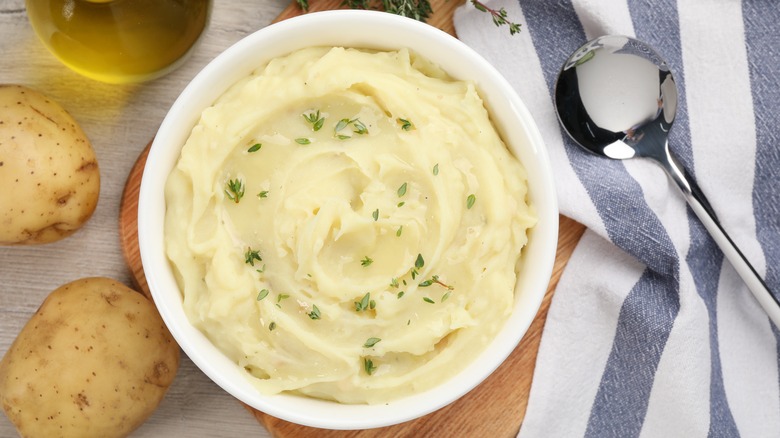The Healthiest And Unhealthiest Ways To Cook Potatoes
Potatoes are a dietary staple across the globe, and only rice and wheat are eaten in larger quantities. But potatoes have gotten a bad rap in dietary circles in the last decade or so, with low-carb fads putting some people off eating them altogether. However, they're pretty healthy when cooked the right way.
Potatoes contain plenty of nutrients, including vitamin C and potassium, and some methods of cooking preserve those nutrients better than others. They are also extremely low in fat, but of course many of our favorite ways to eat them involve coating them in oil.
To help you make the healthiest choice for you and your family, I explored the healthiest and unhealthiest ways to cook your spuds, so you can work out which ones are fine for everyday cooking, and which should be saved as an occasional treat. From steamed and boiled to potato chips and mash, I'll cover the most common ways to eat potatoes — and dive in to what's healthy and what isn't.
Healthiest: Boil
If you want your potatoes to be as healthy as possible, one of the best ways to cook them is to boil on the stove. It is a straightforward cooking method that makes the spud the hero, without adding too much else.
The major benefit of boiling potatoes is that no fat is needed in the cooking process. This means they can be enjoyed without the added calories that fat brings, or you can easily control the quantities if you want to add butter once they are cooked. Add a pinch of salt to the cooking water while boiling and choose other seasonings such as herbs to add flavor once they are cooked.
The main negative when boiling potatoes is that some of the nutrients can be lost to the water. Vitamin C and potassium are two important nutrients in potatoes, but since both are water soluble, they can end up in the water, and subsequently down the drain. Boiling potatoes with their skins on can reduce the nutrient loss — but make sure not to overcook them, because the longer they spend in the water, the more significant the loss will be.
To find the best potatoes for boiling, you should look for a waxy variety. Their lower starch content means they are less likely to fall apart when boiled since they won't soak up as much water. New potatoes are a great option — they have plenty of flavor and will hold their shape nicely, making them more attractive for plating up.
Unhealthiest: Deep fry
One of the reasons potatoes are the most widely eaten vegetable in the United States is the increasing popularity of the deep fried form. According to the Agricultural Marketing Resource Center, 63% of potatoes sold in the U.S. will be turned into into fries, chips, and other products that don't resemble the original vegetable. Unfortunately, deep fried potatoes represent one of the least healthy ways to prepare them.
Deep frying potatoes in oil drastically increases the fat content and subsequently the calories they contain. French fries can have more than three times the number of calories than the equivalent sized potato when it is baked, and exponentially more fat, since the baked version is virtually fat-free.
The type of fat the fries contain raises more concern, as the likelihood of dangerous trans fats being present is high, especially if you are eating out. Trans fats form when oil is heated to very high temperatures, as in deep frying, but evidence suggests that the more often the oil is heated, the more trans fats are formed.
If you must deep fry your potatoes, use paper towels after frying to remove as much excess fat as possible. Eat deep fried potatoes as a rare treat rather than on a regular basis. And, as often as possible, choose another cooking method, to enjoy your spuds in a way that your body will appreciate, too.
Healthiest: Steam
Steaming potatoes is not as common a cooking method as boiling, but if everyone knew the health benefits involved, they would add it to their culinary repertoire. Steaming is a similar chemical process to boiling, but because the vegetables don't actually sit in water, it's a healthier option. This is the crucial difference, as it prevents water soluble vitamins and minerals from leaching into the pan, rather than ending up on your plate. If you've ever steamed broccoli or asparagus, you will notice how they retain their vibrant green color when steamed, whereas boiling them can result in a more insipid, washed out tone. Although the effect is not as visible in potatoes, the same thing is essentially happening.
Steamer baskets are inexpensive and make steaming potatoes and other veggies straightforward. Simply fill a large pan with water up to the bottom of the basket, then add the potatoes once the water is boiling. This allows the potatoes to cook in the hot steam, without becoming waterlogged or losing their precious nutrients.
As with boiling, you want to use waxy potatoes such as fingerlings and new potatoes — they keep their shape well. Steaming can take slightly longer than boiling, but the increased flavor will be worth the wait. You can drizzle a drop of extra-virgin olive oil once they are ready, and a handful of fresh herbs will brighten the flavor even further.
Unhealthiest: Hash browns
Hash browns are a delight to have for breakfast, or at any other time of day, but they are not exactly the healthiest way to prepare potatoes. They tend to consist of shredded potato and onion, coated in flour then fried in plenty of oil. While utterly delicious, if you're trying to reduce calorie or fat intake, this is not a great option.
The good news is there are a couple of ways to make your hash browns healthier if you are cooking them at home. Firstly, add some grated vegetables into the mix to boost the nutritional profile. Carrots, cauliflower, and sweet potato all work really well, and are packed with vitamins and minerals. You can also bake the hash browns in the oven with a drizzle of oil, immediately reducing the amount of fat they will absorb. If you are concerned that they won't pack as much of a flavor punch being cooked this way, add some herbs and spices into the mix. A touch of oregano or paprika will more than make up for the lack of oil. By slightly tweaking your hash brown recipe, you can transform them into a much healthier version you can serve alongside poached eggs and baked tomatoes for a filling and satisfying breakfast.
Healthiest: Bake
Baked potatoes are considered to be one of the healthiest ways to enjoy your spuds, especially if you eat the skin. The process of baking allows them to keep hold of their nutrients more than with boiling, and the lack of oil keeps the calorie count down. This means in spite of their popularity as a comfort food, they are actually pretty healthy all round.
The best potatoes for baking are starchy spuds that can fluff up in the middle and soak up any topping you choose to add. Be sure to poke some holes in it before cooking to allow any steam to escape. For the perfect crispy baked potato, cook in a hot oven — around 350 degrees Fahrenheit — for an hour or so.
The point at which a baked potato can veer off the healthy track is when the toppings are added. Up until that point, it makes a nutritious and low fat lunch, side dish, or light meal — but once sour cream and cheese come knocking, things can turn unhealthy quickly. If you want to keep your baked potato healthy but still delicious, opt for tuna, baked beans, or cottage cheese. If plating it as a side dish to meat or fish, a drizzle of olive oil and some chives will be enough to add flavor without derailing your health goals.
Unhealthiest: Pan fry
When considering the healthiest way to cook your potatoes, you may be wondering where pan frying fits in. If deep frying potatoes is a big no-no, do sautéed potatoes need to come off the menu too? The answer is complicated, but essentially shallow frying is a healthier option than deep frying, but less healthy than boiling or baking.
The big difference between deep and shallow frying is the temperature of the oil. Deep frying requires temperatures up to 400 degrees Fahrenheit, whereas pan frying is around 350 degrees Fahrenheit. Cooking at high temperatures causes dangerous compounds to form that can create inflammation in the body, ultimately leading to disease.
Cooking unstable oils at high heat can also cause trans-fats to be produced, which you don't want to happen to your healthy potatoes. The Mayo Clinic notes that trans fats have been shown to be detrimental to heart health, and can cause strokes and diabetes. Choosing oils with a high smoke point reduces the chances of trans fats being formed, so opt for refined avocado oil or sunflower oil when pan frying your potatoes.
Reduce the salt needed in your pan fried potatoes by cooking them with garlic and herbs such as rosemary. This will boost the flavor and make it more likely that you can leave the salt in the cupboard. Sautéed potatoes can be enjoyed as an occasional treat and a healthier alternative to fries, but choose another option on this list if you are planning on having potatoes regularly.
Healthiest: Microwave
If you are a dedicated home cook, microwaving potatoes may feel a bit like cheating, but it is actually a great way to save time and create healthy potatoes. There is a myth that microwaving food depletes nutrients, but this is not true. In fact, compared to boiling, Science Focus says microwaving potatoes can result in more vitamins and minerals making their way to your plate.
The great thing about microwaving potatoes is that it can be the first step for other ways of preparing them. While you can simply microwave potatoes and serve as you would boiled or steamed spuds, the microwave can also be used in place of par-boiling before roasting or baking a potato. You can then transfer to a hot oven to allow them to finish their journey to crispy perfection. This can save you time, but also money since you won't have to heat a large oven for well over an hour.
You can also make mashed potato in the microwave, to save you messing about with pans on the stove. Cook the potatoes fully in the microwave, then mash as you would boiled potatoes, creating a quick and mess-free alternative to your usual mash.
In short, microwaving potatoes is a quick and easy way to create a healthy side dish for your midweek dinners. So, the next time you are pressed for time, look to your trusty microwave to help you out.
Unhealthiest: Potato chips
If you are intent on following a healthy diet, it's unlikely that you're under the impression that chips are a healthy way to eat potatoes. But just how do they stack up compared to the other forms of cooking our favorite tuber?
The first way in which potato chips are unhealthy is the amount of calories, fat, and sodium they contain due to being deep fried and heavily seasoned. However, there is another factor that makes snack foods like chips so damaging for our health in the long term.
Nutritionists use the phrase 'hyper-palatable' to describe foods that are so ludicrously tasty that we just can't get enough of them. These foods are more likely to be overeaten, leading to higher caloric intake overall. Stephan Guyenet, a neuroscientist who is the author of the book "The Hungry Brain" points out that overeating potatoes themselves is fairly difficult, whereas potato chips, coated in fat and salt, are very easy to mindlessly binge on. So, not only are they much higher in calories and fat to begin with, but we end up eating a significantly larger portion, meaning a double attack on our health.
Next time you feel a craving for potato chips, make some yourself by baking thinly sliced potatoes in the oven. This way you can control the amount of fat and salt they contain, and can replace some of the sodium with dried herbs and spices instead.
Healthiest: Air Fry
Since air fryers first became popular in 2017, they have revolutionized the way people cook in their home. They allow you to get the effect of fried foods without using a deep fryer, and with a minimal amount of oil, meaning you get all of the flavor with fewer calories. Air frying your potatoes will allow you to crisp them up, similar to roast potatoes or fries, but without the grease associated with those versions.
To get the best out of your air-fried potatoes, cut them into wedges, toss them in a very small amount of oil, and season them generously. As well as the usual salt and pepper, add dried herbs, Cajun seasoning, or even cinnamon for a unique twist.
Compared to a conventional oven, an air fryer can cook potatoes much more quickly, so the wedges should be done in around 15 minutes at 400 degrees Fahrenheit. In addition, Healthline reports on a study that shows air frying instead of deep frying could reduce the formation of acrylamide by as much as 90%. Acrylamide has been shown to cause cancer in mice, and is considered a neurotoxin and likely carcinogen in humans, so cooking potatoes in a manner that produces less acrylamide is definitely what we want. Added to the ease of clean-up, this puts air frying squarely on the list of potato cooking methods to try — so if you have an air fryer but haven't yet added your spuds, now is a great time to start.
Unhealthiest: Roast
Roast potatoes are a popular choice when it comes to making spuds at home, and are pretty much compulsory if you are serving any sort of roast meat. But working out how healthy roast potatoes are isn't straightforward, and depends on a number of factors.
Compared to deep frying, roasting potatoes will allow you to control how much oil they are cooked in and will therefore absorb. Choose an unsaturated oil such as olive oil for your roasties and don't turn the oven up to max, as the hotter it is, the more likely the oil will form dangerous compounds. Rather than pouring the oil over the potatoes in the baking tray, add them to a large bowl then measure out a spoonful or two of oil and pour it over. You can then thoroughly shake or turn the potatoes in the oil to ensure each surface is covered, before adding to the baking tray and cooking.
Alternatively, you can add the oil to a spray bottle, then spray a fine mist of oil across the potatoes. This is a great way to reduce your oil consumption overall, using it to spray the pan before cooking a variety of foods. Leaving the skin on your roast potatoes will increase the nutrients you consume, since skin contains more essential minerals than the flesh, such as potassium and magnesium. So while roast potatoes are usually unhealthy, a few tweaks can ensure they're a reasonable option, especially if only eaten occasionally.
Healthiest: Mash
Is there any more comforting side dish than a big bowl of fluffy yet creamy mashed potatoes? Probably not, but the health profile of mash depends heavily on how you prepare them, and the creamier and more decadent they are, chances are they are going to be tipping the scale toward the unhealthier side.
To balance the books and keep mashed potatoes on the straight and narrow, start by using the correct spuds. If you can get a great texture from the potatoes alone, you will be less likely to add lashings of cream and butter. Russets or Yukon Golds are both great options and will give you a mash that tastes great before you even start to season it.
When it comes to additions to your mash, cream, butter, and cheese are the most common, but also most calorific, so you will need to think outside the box if you want to keep it healthy. Greek yogurt is a delicious, tangy replacement for cream that is much lower in fat, and will still create a creamy texture. Cottage cheese or ricotta can be an ideal substitute for regular cheese, keeping the salt and fat levels lower.
Adding roasted garlic to your mash will give it a huge punch of flavor that means you won't miss the butter or cream. Roast a couple of cloves whole, with the skin on, then simply mash them in with the potatoes for a wonderful depth of flavor with virtually no added calories.

